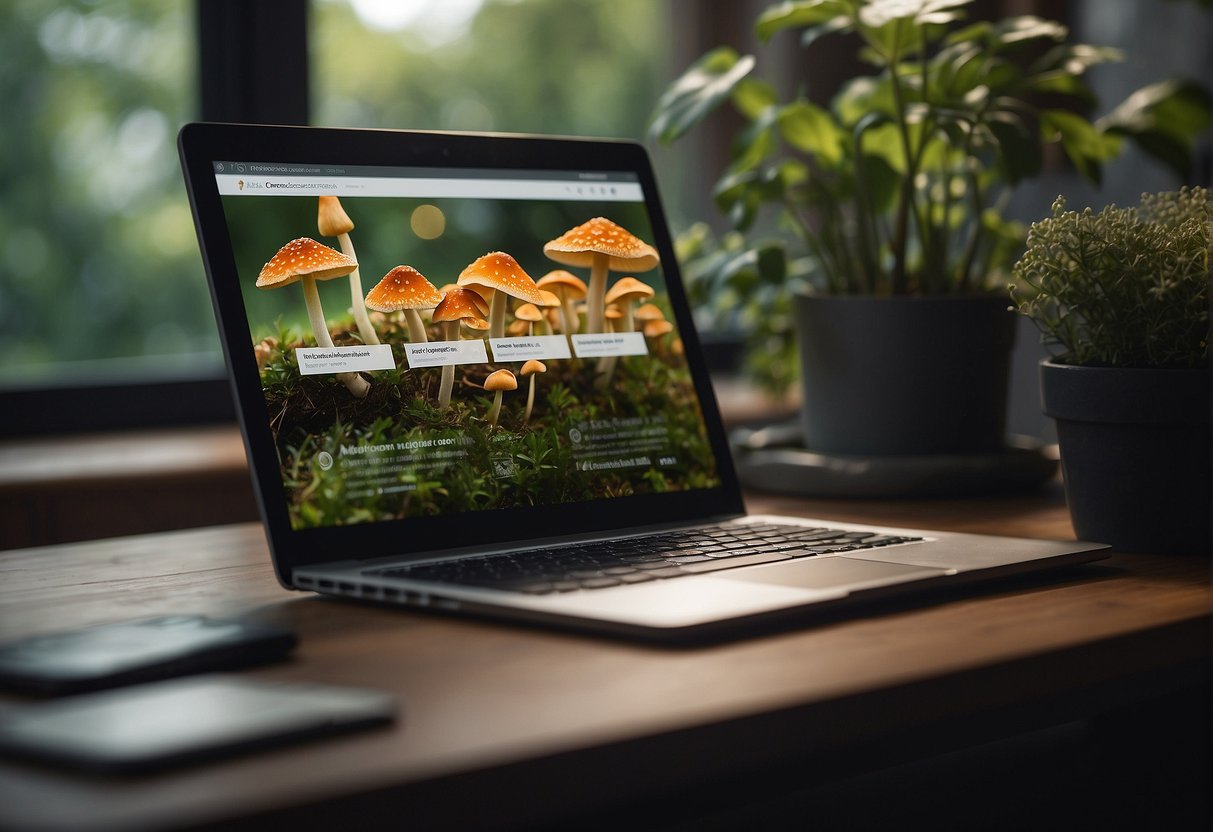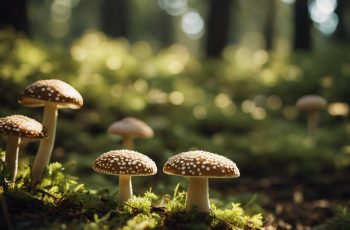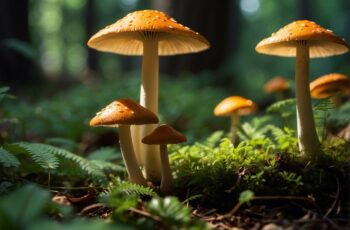Embarking on a woodland trek, you might often find yourself curious about the various mushrooms dotting the forest floor. Identifying these enigmatic fungi is now more accessible than ever with online mushroom identification tools. Whether you’re a seasoned forager or new to the game, the digital age offers a wealth of resources that can help you learn more about the mushrooms you encounter. Equipped with these tools, you gain not just knowledge but also an added layer of safety, ensuring your mushroom hunting is both rewarding and responsible.

Online resources provide detailed visual guides that are invaluable for comparing and contrasting different mushroom species. Websites like Mushroom World offer extensive photo libraries, grouping mushrooms by family to facilitate easier identification. For a more interactive experience, there are AI-powered platforms like FungusID and apps that train algorithms with millions of images, ensuring a more accurate identification for even the most obscure find.
Your foraging experience is greatly enhanced with these tools at your disposal. They are designed to be user-friendly, so even without prior knowledge, you can start identifying mushrooms with confidence. These online guides often come with descriptive information on habitats, seasons, and edibility. Such features not only make online mushroom identification an informative pursuit but also a safe and enjoyable addition to your outdoor adventures.
Basics of Mushroom Identification
When starting your journey into the world of fungi, knowing how to identify mushrooms properly ensures a rewarding and safe experience. The ability to correctly distinguish between different species of mushrooms relies heavily on understanding their anatomy and recognizing their broader categories.
Understanding Mushroom Anatomy
Fruiting Body: The main structure you see above ground is the fruiting body. This is the part of the mushroom that we typically recognize. It consists of a cap and a stem (stipe), and sometimes gills, pores, or teeth underneath the cap.
- Cap Shape: The shape can vary widely, from the common umbrella-like form to more unique shapes like conical or flat-topped.
- Stem Characteristics: The thickness, color, and texture of the stem are important identifiers.
- Gills, Pores, or Teeth: Gills lie underneath the cap for many mushrooms, but some mushrooms, like the bolete, have pores. Polypores, another category, have many tiny holes where the spores are released.
Categories of Mushrooms
Mushrooms can be categorized into several types based on their spore-dispersing structures.
- Gilled Mushrooms: These fungi have blade-like gills under the cap, which may be closely or broadly spaced. Spores fall between these gills to begin new growth.
- Boletes: Identified by their pore-covered surfaces beneath the cap instead of gills. When identifying a bolete, examine the color and shape of the pores meticulously.
By focusing on these anatomical features, you’ll be better equipped to use identification guides and avoid the common pitfalls encountered by beginners. Remember to consult detailed descriptions and identifications from reliable sources to confirm your findings.
Identifying Common Mushroom Types
When foraging for mushrooms, it is crucial to distinguish between those that are safe to eat and those that are harmful. Correct identification is key to a safe and enjoyable experience.
Edible Mushroom Varieties
-
Chanterelle (Cantharellus spp.): Recognized by their golden-yellow color, these mushrooms have a unique, vase-shaped cap and false gills, making them a popular choice for foragers. They are renowned for their delicate flavor and are best identified by their distinct appearance rather than spore prints. Further identification details for chanterelles are available on Mushroom Appreciation.
-
Morels (Morchella spp.): Highly sought after, morels have a distinctive honeycomb-like cap. They come in various colors, generally being blonde to dark brown.
-
Agaricus (Agaricus spp.): This genus includes the common button mushrooms and portobellos. Features to look for are a cap ranging from small and rounded to large and flat as the mushroom ages, and gills that change from pink to brown with maturity.
-
Polypores: Often found growing on trees, these mushrooms have pores underneath the cap instead of gills. Many have medicinal properties and are not typically used for cooking.
To avoid toxic species, always refer to a mushroom identification chart or consult an expert.
Toxic and Poisonous Fungi
-
Amanita (Amanita spp.): Some of the most lethally poisonous mushrooms belong to this genus, such as Amanita phalloides, known as the death cap. Amanitas often have a distinctive cup at the base of the stem, a ring around the stem, and white gills.
-
Lepiota and Macrolepiota: While some in this group are edible (like Macrolepiota procera, the parasol mushroom), others contain deadly toxins. Identification involves examining the cap scales, ring on the stem, and how easily the cap skin peels away.
-
Lactarius and Russula: Known as milk-caps and brittlegills respectively, these can be identified by their gill structure and the milk or juice they exude when cut. While some are edible, others can cause gastrointestinal distress.
Be aware of false lookalikes and always perform thorough checks, such as spore prints, to ensure the mushrooms you collect are not toxic.
Remember that many toxic mushrooms may resemble their edible counterparts. Use a mushroom identifier tool for assistance, but when in doubt, do not eat the mushroom.
Online Mushroom Identification Tools and Resources
With the advent of technology, you now have access to several online resources that allow for precise mushroom identification. These tools range from comprehensive databases to AI-driven apps, each offering a way to accurately identify various mushroom species for both interest and safety.
Utilizing Online Identification Guides
Before heading out into the woods, familiarize yourself with online identification guides. Websites like FungusID act as a mushroom identification helper using AI to compare your mushroom photos with a vast database. Although you might feel confident about what you pick, bear in mind that the accuracy of these tools may vary, and they are primarily for informational purposes. Be aware of the potential for errors or omissions and cross-reference your finds with multiple sources when possible.
Contribution to Citizen Science Databases
Your passion for mushroom foraging can contribute to broader scientific efforts through citizen science databases. By documenting your finds with apps such as Picture Mushroom, you assist in creating a rich database for others to use. Remember, every photo you upload and every species you help identify enriches the collective knowledge, offering a more accurate and sizeable mushroom identification resource for all.
Best Practices for Safe Mushroom Foraging

When you’re heading into the woods to forage for mushrooms, it’s crucial to prioritize safety and informed identification. To ensure your mushroom-hunting expeditions are both enjoyable and safe, it’s important to distinguish correctly between edible and potentially toxic varieties.
How to Avoid Common Mistakes
Don’t rely solely on color or shape: Many mushrooms that are safe to consume can look similar to those that are not. For instance, the desirable Cep mushroom has toxic look-alikes that require a keen eye to distinguish. Start by studying key characteristics, such as spore prints and the presence of certain features like rings on the stem.
Consult multiple sources: Always cross-reference the mushrooms you find with various reputable guides or use a trusted online mushroom identification training. Remember that some mushrooms, like Lepista nuda, have distinct features which can be confirmed through various sources of information.
Making Informed Decisions
-
Use technology wisely: With today’s technology, there are mushroom identification apps that can help you in the field, but they should be used as a supplementary tool rather than the sole basis for decision-making.
-
When in doubt, leave it out: If you can’t positively identify a mushroom, it’s better not to risk consuming it. Consuming unknown fungi can lead to serious health risks.
-
Educate yourself continually: Attend workshops, such as the online workshops for safe mushroom foraging, to gain more knowledge and stay up-to-date with the best practices in mushroom identification. Knowledge is key, and it’s always free to learn.


